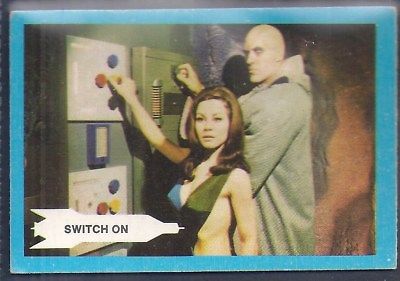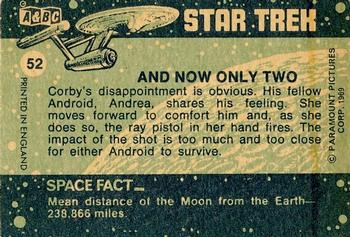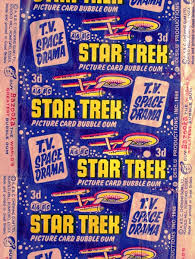Star Trek 1969, A&BC
By Kurt Kuersteiner © 2018 Monsterwax
Trading Cards for The Wrapper Magazine #315

I bet I’m not the only card collector who is turned off by open-ended collections. Those are series that go on forever and you can never finish them because they keep adding more and more sequels to it. Two of the biggest offenders are Star Wars and Star Trek. Now don’t get me wrong; I love both those science fiction series. But when a card franchise starts requiring multiple pages in price guides to list them all, that’s overkill as far as I’m concerned. At present, they hog over eight pages of the NSU guide… and that’s in tiny print!
However, the vintage card sets from either series are another matter. Not only are they free from all the chase card insanity, but they have the added benefit of being from the time when the series originally played. Plus there are not too many different sets to collect. In the case of Star Trek, that’s basically the 1967 Leaf set and “sorta” the 1976 Topps set (which actually came out a decade after the series aired.)
So I was pretty excited when I discovered there was another Star Trek series from the 1960s that I completely missed. The reason why it had escaped my notice was that it wasn’t issued in the USA and you won’t find it in our price guides. It was produced in 1969 by the A&BC company in England (of which Topps owned part). There are a number of reasons this set is worthy of collecting by Star Trek fans.
First off, it’s larger than most British card sets of that time, which tend to be the size of tobacco cards. It’s almost the size of regular US cards, measuring 2.25” x 3.25”. The images are full color photos with powder blue borders. They are also all horizontal images, suggesting they were “film grabs” taken from the actual episode (instead of using a separate on-the-set photographer). But the images are very clear (as compared to “video grabs” which are usually very grainy). All the images are from one particular episode, “What Are Little Girls Made Of”. This was an episode that featured the giant Ted Cassidy (who played Lurch on The Addams Family). He appears bald with sunken eyes and looks very intimidating.
Playing the beauty with this beast is Sherry Jackson, who is wearing one of the sexiest costumes ever featured on Star Trek. Her outfit is even more revealing than others on the show, and it is clear she is not wearing any bra (if you get my “point”). It is no secret that Gene Roddenberry had an eye for the ladies and he selected Hollywood’s hottest babes to excite Star Trek’s nerdy, mostly male audience. He also used the casting couch to satisfy his philandering habits long before Harvey Weinstein came along. In fact, when Star Trek began, he was bedding both Nichelle Nichols (Lt. Uhura) and Majel Barrett (Nurse Chapel) while still married to his first wife! But I digress… The important thing is, if you like monsters or beautiful babes, this set has both.
Now you’re probably thinking, “I’d rather have the 1976 Topps set which has a lot more diversity of episodes.” I agree. After all, plucking photos from different episodes allows a lot more eye candy. But this 1969 set has something rarely offered in other series of the era… a continuous story featured on the back. The entire episode is faithfully retold there. (Just not entirely accurately.) In fact, some of the goofs make it painfully obvious the text writer knew little or nothing about Star Trek.
Take for example, the very first card. “Roger Kirk, Captain of Star Cruiser, United Space Enterprises. Out on a 5-year mission in space to complete research, explore and enforce space law.” Roger Kirk? United Space Enterprises? Enforce space law? Sheeesh!
It gets even worse (or better, depending on your sense of humor) on the second card: “Mr. Spock, Second in Command, is a cross between an Earthman and a Martian.” A Martian? Did the writer miss the memo about Vulcans? Clearly, A&BC didn’t consult Gary Gerani (the text writer at Topps). Gary wrote one of the first books to praise Star Trek, along with other great horror and scif-fi shows of that decade (called Fantastic Television). He must have busted a gut when reading the A&BC backs.

But despite these comic missteps (and maybe a little bit because of them), this set is very collectible. Continuous story cards were a rare bird by the 1960s. (Tarzan’s Crystal Vault was a scarce exception, and that was all the way from the 1930s!) Most non-sports cards are episodic, jumping around from story to story, or worse yet, fill the backs with the dreaded “puzzle photos”. This series not only tells the whole story, but it also features an attractive graphic, and in some instances, a “space fact” at the bottom. (e.g., “Largest known Star… Red Giant, diameter 2,500 million miles.”)
Another funny aspect to this series is the white graphic on the front that encapsulates the card title. It’s in the shape of a 1950s style rocket. I’ve seen all 79 of the original Star Trek TV series, and I don’t think I saw a single rocket in the any of them (unless they were going back in time a few hundred years). Talk about an anachronism-- These guys just didn’t get it—but even so, there’s a thing called beginner’s luck. And they seemed to have a good deal of it when making this set. 15 of the 55 cards feature Lurch as “Ruk”. He’s incorrectly called “Rock” on the cards (no surprise.) 13 of them feature the sexy Jackson as Andera. 12 feature the rarely seen Nurse Chapel (rarely seen in cards, but not by Roddenberry!) She would later replace his then current wife and inherit Gene’s mega-fortune when he died in 1991. Lt. Uhura is also seen in the same episode, but not shown in the cards. Surprisingly, Mr. Martian (I mean, Spock) only appears in two cards. (That’s probably a first for any of the original Star Trek card series.) But as if to make up for it, Captain Kirk appears in 35 of the 55. Seems a bit much? Well, the episode involves androids that create a Kirk duplicate, so there’s some double exposure (so to speak).
I really enjoy the backs to this series, including some of the dated space facts, like the one on card #26: “Largest planet in the Universe—Jupiter, diameter 88,700 miles.” We only knew of nine planets back in 1969. Since then, Pluto was subtracted and billions more added from outside our solar system. Considering we had never left our own orbit in 1969 (since the moon is technically inside it), nor had we seen even 1% of the universe with our limited telescopes, it might have been wise not to deny the possibility of more planets out there, bigger or otherwise. (Especially when watching Star Trek!)
Suffice it to say, I like this series, flaws and all. Check out the text from the last card, #55: “The Star Ship Enterprise, flagship of the space fleet of United Space Enterprises, wends [sic] its way across the skies…” And all this time you thought space ships traveled in the vacuum of space… That’s one of the things I appreciate about non-sports. We don’t waste our time learning pointless sports trivia like they do with the backs of sports cards: No, we learn facts, scientific facts (like space facts) that make us smarterer. Knowledge like that can make Martians like Spock green with envy.
Finding this set is no easy task in the USA. I was lucky to find a VG/EX set for $250 (if you include the stuff I traded for it). I also saw an EX version sell quickly on eBay for $400 BIN. I suspect given its scarcity, that if it had originally been issued in the USA (but was recalled like the 1967 series was), you would see even higher prices than the Leaf set. Those are smaller cards as well, are more common in the states by comparison, and are B&W to boot. But I find these more endearing, for the reasons discussed. At very least, if you collect vintage Star Trek, you’ll want a sample card from this series. Just beware… because they can become habit forming!

(Above: AB&C wrapper)